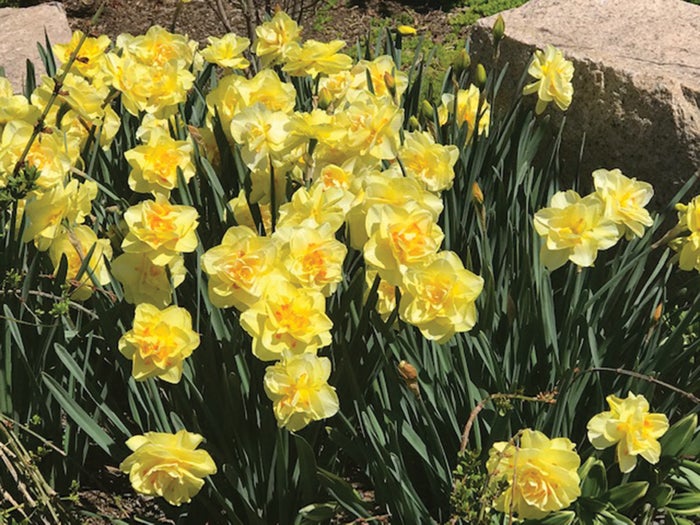April lawn and garden tips
Published 12:00 am Friday, April 5, 2019

- Submitted photo Double daffodils. Spring bulbs should be left until the leaves turn brown. The plants are storing energy.
By Amy-Lynn Albertson
Rowan County Extension Director
Spring gardens should have been planted back in March. But March was really wet and cold so most of us didn’t get anything planted and those that did, got a late start. You can still plant leaf lettuce, beets, radishes and carrots in April.
April is the month when you should really be working on preparing your soil. Now is the time to begin tilling the soil and adding any amendments that may be needed such as compost or lime. If you till your soil several times prior to planting you will have fewer weeds and a finer seed bed. Our frost-free date is April 15. You can plant your corn, cucumbers and tomatoes once the soil has warmed up and stays warm.
Starting seeds: Now is the time to start your tomato and pepper seeds indoors under lights. You will need an average of four weeks to grow your seedlings so they can survive in the garden. Most packets of seeds say you should give double that time, but in general, four weeks is enough to get the plants started and when you plant them they are still vigorously growing and have not become root bound.
Cabbage worms: If you plant your spring garden in May, include any of the cole crops such as cabbage or broccoli; you will soon see cabbage worms. There are two types of these — the cabbage worm and the cabbage lopper. Moths lay eggs on your plants and then the larva (worms) proceed to devour the leaves, destroying your harvest.
If you have these, don’t fret. There is an effective biological control known as Bacillus thuringiensis. These are sold under the name Dipel and Thuricide to name a few. The worms consume the bacteria and become sick, just as we would if we got a bacterial infection. This can eliminate the pest without harm to any humans.
Stay out of the garden when the soil is wet. Our clay soils are already compacted. Working in or on wet soil worsens the compaction markedly by decreasing the pore spaces available to hold oxygen. Neither gardeners nor their plants can survive without oxygen. In addition, working around wet plants is a good way to spread diseases.
To decide if the soil is suitable for tilling, plowing or digging, take a handful of soil from 4 to 5 inches below the surface and squeeze it in your fist. If it crumbles, the soil is workable. If it holds its shape, it is still too wet, and you’ll pay for a long time afterward for not letting the soil dry out for a few more days.
Perennial plants: These should be set out this month so they may become established before hot weather sets in. Prepare beds using leaf compost or pine bark.
Summer bulbs: These can be planted in late April. These include dahlias, gladiolus, tuberoses, fancy-leafed caladiums, elephant ears, amaryllis and cannas.
Start digging and storing early flowering bulbs such as ranunculus and anemones as their foliage begins to yellow. After the petals fade and fall off, remove flower heads with scissors or hand pruners, and allow the foliage to die a natural death. This allows the plant to store necessary nutrients in the bulb for next year.
Now is the time to aerate warm season lawns (Bermuda, zoysia, centipede, St. Augustine) to warm the soil temperatures and allow for better water infiltration and gas exchange.
Flower bed preparation: Prepare new flower beds now for this spring. Summer annuals and bulbs perform better and for longer periods if planted in well-prepared beds. Although it is too early to plant, it isn’t too early to till, incorporate organic matter, lime and fertilize. If the area is worked now, a shallow “fluff-up” and hand raking is all that is necessary at planting time.
Azaleas and camellias: As new growth emerges, leaf gall on azaleas and camellias are best controlled by handpicking the fleshy leaves and destroying them. Lacebugs are the most common insect pest on azaleas. Watch for whitish, tippled leaves with tiny flecks on the undersides of the leaves. Since lacebugs feed on the undersides of the leaves, non-systemic material such as horticultural oil and insecticidal soap must be applied there. Thorough coverage is essential and repeat applications will probably be necessary.
Apples and pears: Fireblight of apples and pears are common diseases this time of year. A copper sulfate-based spray should be applied a few weeks prior to blooming and continued until the blooming period has been completed. A regular spray program must be maintained throughout the growing season to prevent and control other disease if you want acceptable fruit. If you have horticulture questions, please call our office at 704-216-8970.
Mark your calendars for the Rowan County Master Gardener Volunteer Association Plant Sale May 4. We will have lots of pass-along plants, succulents and ornamentals. The sale is 8:30 a.m.-noon.
The use of brand names in this information does not imply endorsement by the North Carolina Cooperative Extension Service of the products or services named nor discrimination against similar products or services not mentioned.



